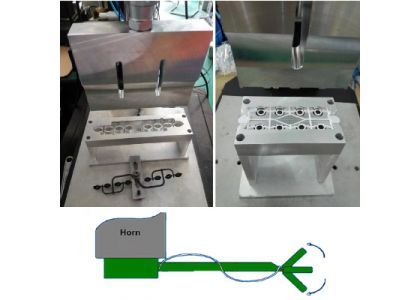
After the plastic product injection molded, it is time-consuming and labor-intensive to cut the unnecessary plastic runners. Adopt the ultrasonic degating technology, dozens of product runners can be removed instantly, and the efficiency is extremely high. In recent years, products in the zinc alloy or aluminum alloy die-casting industries have increasingly used high-frequency ultrasonic vibration energy to remove plastic or metal gates.
Place the workpiece in the fixed model, start the switch button, the ultrasonic vibration head(ultrasonic horn) goes down, the ultrasonic vibration is transmitted to the connection between the runner and the product, the high stress will cut off the workpiece inlet runner, the runner surface is flat and smooth, not white, As beautiful as direct injection molding, it saves a lot of labor and improves production efficiency.
The ultrasonic plastic degating machine is especially suitable for rigid thermoplastics, such as polystyrene (PS), nylon (PA), ABS, PC, AS, PMMA etc. Soft thermoplastics have poor cross-section consistency after degating.
The advantages of ultrasonic degating:
high efficiency, short cycle (less than 1 second), clean section, and convenient for automatic manufacturing.
Use the robot arm of the injection machine to pick up the product and place it on the ultrasonic vibrating head (ultrasonic horn). At the same time, the program trigger the ultrasonic. The required plastic parts will automatically fall off, and then the robot arm will take away the runner tree, It is convenient and fast, and realizes the automatic degating no worker are on duty, which greatly improves production efficiency.
The principle of zinc alloy die-cast degating, zinc alloy degating, aluminum alloy degating is the same as that of injection molded parts. What we should be pay attention is that many die-casting processes of zinc alloy are simultaneous injection in multiple directions. therefore it needs more powerful ultrasonic machine to degate it .